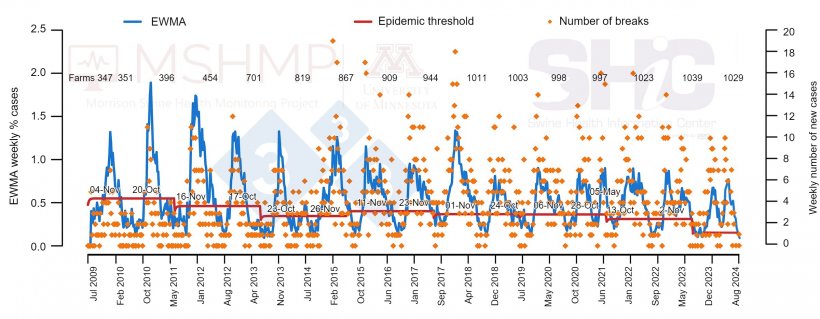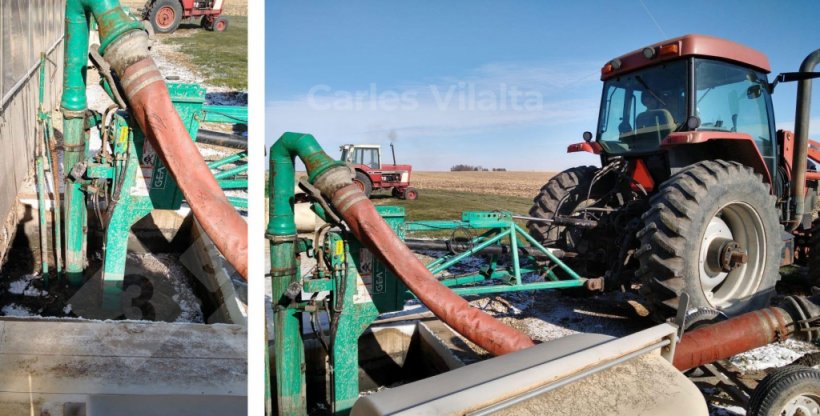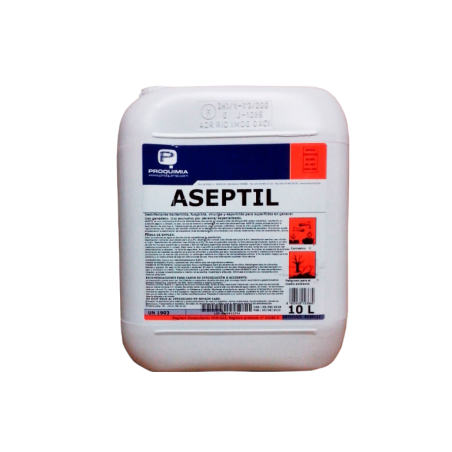Forty percent of breeding farms experienced a Porcine Reproductive and Respiratory Syndrome (PRRS) outbreak within one month of agitating the manure pit, according to the University of Minnesota (UMN) Morrison Swine Health Monitoring Project (MSHMP). This startling statistic highlights the complex relationship between manure management and the spread of the PRRS virus (PRRSV). As researchers delve deeper into the epidemiology of this costly disease, the role of manure as a potential vector has come under increasing scrutiny. In this article, we explore available information regarding the relationship between PRRS occurrence and this common practice.
Fifteen years’ worth of data has allowed MSHMP to confidently conclude that PRRS is a cyclical and seasonal disease (Figure 1). In USA, the onset of the yearly epidemic begins every year during the fall, where most of the cases are reported, and peaks between January and February when case frequency begins to decrease. However, a second peak of cases during late-spring and early summer that is not always apparent also occurs, it is usually composed of fewer cases. Those two periods coincide with the moment in which manure pit agitation, pumping and field incorporation practices occur.


Key Study on Manure Management and PRRS Outbreaks
The role of manure in PRRSV spread and consequently developing a clinical PRRS outbreak has been a recurrent topic since the disease was first identified. However, it wasn't until 2020 that a study definitively demonstrated the temporal relationship between manure management practices and the probability of breeding herds reporting a PRRS outbreak. Conducted between July 2019 and June 2020, the study collected data from 150 breeding herds which showed that manure pumping in the U.S. occurred mostly in October (40), April (29), and November (24).
The results indicated that after agitating and pumping the manure pit:
- 25% of the breeding herds experienced a PRRS outbreak within the first 15 days.
- 40% of the farms had a PRRS outbreak within 30 days.
- The overall risk of a PRRS outbreak was 12 times higher during the first 15 days after pumping manure than the rest of the year.
This relationship held true across various conditions, including different seasons, manure storage types (e.g., pit vs lagoon), farm location (e.g., high vs low pig density regions), herd sizes, and breeding herd PRRSV status. Potential reasons for this include increased manure spreading activity, lack of biosecurity measures, or exposure to residual virus in the manure. However, the exact mechanisms remain unknown.

Shedding and Survivability of PRRSV in Manure
Despite limited studies on PRRSV shedding in urine and feces, some relevant findings exist:
- A 1993 study by Yoon et al. highlighted that PRRSV can be shed in the feces of infected animals for up to 35 days, with more frequent recovery from feces than nasal swabs.
- Montoya et al., 2024 found that the virus could be detected for up to eight weeks post-infection in manure collections and up to ten weeks in rectal samples. However, no viable virus was recovered, likely due to the low virus quantities and sample complexity.
Shedding of PRRSV through feces is intermittent and low in quantity, suggesting low survivability in manure
This was confirmed by several experimental studies:
- Pirtle and Beran (1996) only recovered viable virus on the first day of a PRRSV-inoculated slurry.
- Dee et al. (2005) assessed the viability and infectiousness of PRRSV in slurry, finding that its survival is relatively short (one to eight days) and temperature dependent. Pigs can become infected through contact with contaminated effluent.
- The temperature effect was quantified by Linhares et al. (2012) showing that the higher the temperature the lower the half-life of the PRRSV in manure.
Understanding the Neighborhood Effect and Viral Aerosolization
Given the low quantities and short survivability of PRRSV in manure, how can manure management practices be linked to PRRS outbreaks? One hypothesis is the neighborhood effect, where farms that are geographically close have an increased risk of disease transmission due to factors like environmental conditions, and movement of animals, people, and equipment. The window to pump manure in some of the U.S. regions (for instance, the Midwest) is very narrow and concentrated in specific periods. These means that there are lots of tractors loading, moving and spreading the manure in the area. All this movement and spread of manure maybe increasing the infection pressure due to aerosolization of manure (either within the farm or outside the farm) and contamination of close fields and roads due to the constant traffic of manure loaded vehicles (tractors or tankers).
To investigate the presence of different virus at the manure, UMN researchers estimated the prevalence of PRRSV and different swine coronaviruses in pig barn manure pits (Montoya et al., 2021).
Table 1: Percentage of positive samples (RT-PCR) from 385 manure pit samples from Minnesota and Iowa pig farm.
| Virus | % PCR positive samples |
|---|---|
| PRRSV | 7.75%* |
| PEDV | 13.79% |
| PDCoV | 5.46% |
| TGEV | 0% |
*The PRRSV-positive samples had a median Ct value of 37.56 and ranged between 35.48 and 39.57 which overall indicate a low viral load. Further testing was conducted through virus isolation, but no virus was isolated. Adapted from Montoya et al., 2021.
Implications and Future Directions
These findings highlight the potential role of manure management practices on virus transmission and the importance of strict biosecurity measures during manure handling to mitigate these risks. Enhanced understanding and continued research into the role of manure in PRRS epidemiology are crucial for developing effective preventive and control strategies to mitigate the impact of this disease.

Further research is needed to understand viral viability and improve detection methods in manure samples. Exploring the neighborhood effect and the potential magnifying effect of multiple farms spreading manure simultaneously could provide deeper insights into the complex dynamics of PRRSV transmission.








